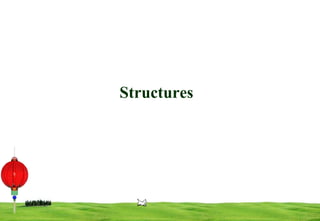
Structure
- 1. Structures 1
- 2. User-Defined Types • C provides facilities to define one’s own types. • These may be a composite of basic types (int, double, etc) and other user-defined types. • The most common user-defined type is a structure, defined by the keyword struct. 2
- 3. Structures • A structure is a collection of one or more variables, possibly of different types, grouped together under a single name • Structures are user-defined aggregate types. • They assist program organisation by – Grouping logically related data, and giving this set of variables a higher-level name and more abstract representation. – Reducing the number of parameters that need to be passed between functions. – Providing another means to return multiple values from a function. 3
- 4. Structure Syntax • A structure is defined by the keyword struct followed by a set of variables enclosed in braces. • Consider the following structure to represent a person’s details. struct Personnel { char name[100]; int age; double height; }; • The variables name, age and height are called members of the structure type Personnel. 4
- 5. Declaring Structure Variables • There are two ways to define variables of a particular structure type. 1. Declare them at the structure definition. struct Personnel { char name[100]; int age; double height; } p1, p2, p3; /* Define 3 variables */ 2. Define the variables at some point after the structure definition. struct Personnel p1, p2, p3; /* Define 3 variables */ 5
- 6. Initialising Structure Variables • A structure may be initialised when it is defined using brace notation. struct Personnel captain = {“Fred”, 37, 1.83}; • The order of values in the initialise list matches the order of declarations in the structure. 6
- 7. Accessing Members • Members of a structure type may be accessed via the “.” member operator. struct Personnel captain; strcpy(captain.name, “Fred”); captain.age = 37; captain.height = 1.83; printf(“%s is %d years old.”, captain.name, captain.age); 7
- 8. Nested Structures • Structures may be defined inside other structures. struct first { struct second { int a; }s; double amount; }f; • To access lower-level members, need to use member operator multiple times. f.s.a = 2.1; f.amount = 75.4; 8
- 9. Operations on Structures • Structure types only support one of the operations that are permitted on primitive types. – Assignment (ie., copying) is permitted – All other operations (ie., arithmetic, relational, logical) are not allowed struct Personnel p1 = {“Fred”, 37, 1.83}; struct Personnel p2; p2 = p1; /* Valid. */ if (p1 == p2) /* Invalid. Won’t compile. */ printf(“People are equaln"); if (strcmp(p1.name, p2.name) == 0 && /* Valid. */ p1.age == p2.age && p1.height == p2.height) printf("People are equaln"); 9
- 10. Structures and Functions • Structures may be passed to functions and returned from functions. – Like all variables, they are passed by value 10
- 11. Pointers to Structures • Defining pointers is the same as for variables of primitive types struct Personnel captain = {“Fred”, 37, 1.83}; struct Personnel *pp; pp = &captain; pp->age = 38; /* captain.age is now 38. */ 11
- 12. Arrays of Structures • The definition of arrays of structure types is the same as for arrays of primitive types. struct Personnel pa[10]; 12
- 13. Self-Referential Structures • A structure may not contain a variable of its own type. struct Node { int item; struct Node n; /* Invalid */ }; • However, a structure may contain a pointer, self referential structure struct Node { int item; struct Node *pn; /* Valid */ }; 13
- 14. 14
- 15. Example: A Linked List • Linked lists come in two basic varieties: singly linked and doubly linked. • We describe here a simple version of a singly linked list. • List consists of a set of nodes, where each node contains an item and a pointer to another list node. struct List { int item; struct List *next; }; • (Here we have chosen an int as the contained item. Any other type(s) may be used.) 15
- 16. Singly Linked List • List is formed by connecting the pointer of one node to the address of the next. • We keep a pointer to the head of the list. This permits traversal. • The end of the list is marked by a NULL pointer. • Example, to start at the head of the list and traverse to the end node: struct List *node = head; while (node->next != NULL) node = node->next; printf(“Last node item: %d“, node->item); 16
- 17. Linked-List Properties • Linked-Lists are useful because they can be grown (or shrunk) very easily. Unlike arrays, there are no issues of reallocating memory and copying data. • Nodes can even be inserted (or removed) from midway along the list without difficulty (and efficiently). 17
- 18. Adding Nodes to a List • Show example code for adding a node to the end of the list. • Show example code for adding a node midway through the list. 18
- 19. Splicing in a New Node • Remember that everything is manipulated as an address. Consider the pointer variables, eg., – – – node node->next newnode is address 0x4D is address 0xA1 is address 0xB6 0x4D • 0xA1 Splicing: newnode->next = node->next; assign to 0xA1 node->next = newnode; assign to 0xB6 0xB6 0x4D 0xA1 19
